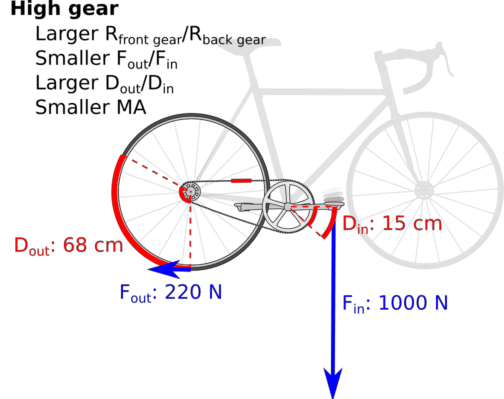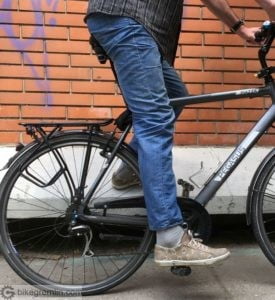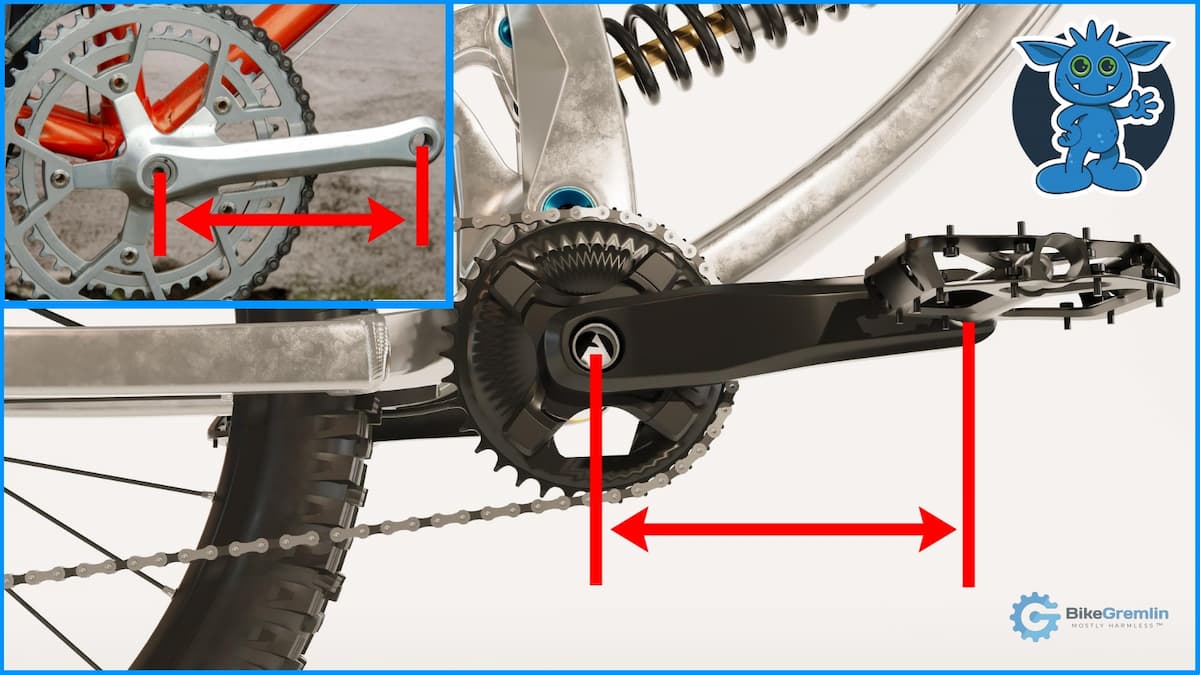This article answers the questions:
“What crankset length should I use/buy?”
“Are 170 mm long cranks better than 175 mm ones, or should I get something in between?”
Table Of Contents (T.O.C.):
- Introduction
- Crank arm (“pedal”) length
- Cyclist’s leg movement range
3.1. Cyclist’s body strain
3.2. Leg movement range
3.3. Pedals’ ground clearance - Rider’s height
- Optimal crankset length – recommendations and conclusion
Table 1 – Recommended cranks lengths according to cyclists’ height range
1. Introduction
Bicycle cranks (or “cranksets” as they are referred to in “bicyclese” 🙂 ) are most often made in lengths of 170; 172.5; and 175 mm. However, both shorter and longer alternatives do exist. Campagnolo has made cranks from as short as 165 mm, to 180 mm long ones. Spanish Rotor makes even 150 mm “long” ones.
Which length is the best? There are three factors affecting the answer:
- Lever length.
- Rider’s leg movement range.
- Rider’s height (leg length, to be more precise).
Let me explain what I mean by these:
For a concise explanation and table chart, skip to section: “5. Optimal crankset length.”
2. Crank arm (“pedal”) length
Cranks are levers with pedals on their end, which we use to propel bicycles.
The longer the lever, the more torque you can apply, but slower. I explained this in more detail in the article: Bicycle gear ratios – gear inches.
A picture from that article that says more than words:

Picture 1
To reiterate: the longer the crank arms, the easier you can pedal the bike in a given gear, but the distance your feet need to cover is increased. This leads us to the next “item:”
3. Cyclist’s leg movement range
When talking about cyclist’s leg movement, we should consider the following three aspects:
- Cyclist’s body strain (I’ll explain below)
- Leg movement range itself
- Pedal ground clearance
3.1. Cyclist’s body strain
The shorter your cranks are, the easier you can spin them fast. Why is this important?
Spinning the pedals faster lets you “displace” the strain from your muscles, to your heart and lungs.
When you pedal slower, with more force/power, it is much like jumping with both legs. You can make a big jump, covering a lot of ground in a short amount of time, but your muscles get exhausted very quickly if you move like that.
Pedaling faster (80 or more revolutions per minute), with less torque, resembles running. Your heart and lungs will work harder, but your legs (and your whole body) will sustain many kilometres with no problems.
If we consider crank length and body strain (rider height being equal), we could say that:
- For technical off-road courses, it’s better to have longer cranks.
- For road cycling, it’s better if cranks are shorter.
3.2. Leg movement range
I’ve already mentioned this, but it’s worth stressing:
Pedaling faster becomes easier when your legs move in smaller circles. The shorter the cranks, the more effortless it becomes to pedal at a high cadence (85 or more revolutions per minute).
3.3. Pedals’ ground clearance
Longer crank arms will put pedals lower when they are at their lowest point (“at 6 o’clock”) during the rotation (relative to the bottom bracket, i.e. crank axle).

Picture 2
This is important for off-road riding, but also when pedalling in a turn (when the bicycle is leaned into a turn) – to avoid pedal strikes on rocks, or pavement.
This all sounds like shorter cranks are the solution to everything, but it’s not really so, as I’ll explain in section: “5. Optimal crankset length.”
4. Rider’s height
Human leg length varies from about 70 to 100 cm (though, for setting a comfortable bike riding position, we usually measure the length from the crotch to the ground, but the principle is the same: leg lengths differ).
Now, if we compare a cyclist with 70 cm long legs to a cyclist with an 80 cm leg length:
Lengthening cranks of both riders by 1 cm is the same in absolute length change, but for the shorter-legged cyclist, that will be a greater relative difference (relative to their leg length). They will feel it more.
Since legs have bones of different lengths, connected with joints, the longer-legged cyclist will need to rotate (“bend”) their joints by fewer degrees in order to have their feet follow the pedals’ full turn on cranks of a given length (I’m not sure how well I’ve explained this).
Here, the up-down motion is the most critical. By that I mean the difference between the highest pedal position (12 o’clock) and the lowest position (6 o’clock). It’s easier when legs are always slightly bent. It’s more difficult if a rider’s legs go from fully straight, to highly bent.
That’s why it’s bad when cranks are too long relative to the rider’s legs length.
5. Optimal crankset length – recommendations and conclusion
So, the main advantage of longer cranks is a longer lever. This used to be very important. In the past century (if anyone reads this in 2101, I mean the XX century 🙂 ), bicycles with short (“easy”) gearing were not widely available. Today, we have cranks with as few as 20-something teeth, and cassettes with over 40 teeth (so, very easy gearing ranges available).
Now, based on all I wrote, you might conclude that shorter cranks are always better, but that’s not really the case. “Pedals too short” can be tricky and uncomfortable when riding, because your leg movement range may be too narrow, and the levers too short, so you always have to shift to a lower gear, especially on technical tracks or when trying to sprint from the saddle.
Therefore, it is optimal to match your crank length with the intended use of the bicycle and your height. That is:
- The taller you are, the longer cranks you need.
- The more you ride off-road (MTB), the longer cranks you need.
OK, so what is the optimal crankset length then?
To a great degree, it is subjective and a matter of personal preference and pedalling style (higher vs lower cadence pedalling). If I had to give a number, I would say that average-height riders (from about 175 to 185 cm) should start with 170 mm cranks, and that 175 mm cranks are probably too long with modern gearing… unless you really ride a lot of off-road. 🙂
Here is a short, rough-guide list of optimal crank lengts for varying cycist heights, with a note that for a lot of off road riding you should add 2.5 mm to the listed crank lengths, and that personal preference can make an additional +/- 2.5 mm difference (personal preference and pedalling style do play a part):
| Rider height (cm) | Recommended cranks length (mm) |
|---|---|
| Up to 160 cm high | up to 160 mm long cranks |
| 160 to 170 cm | around 165 mm |
| 170 to 180 cm | around 170 mm |
| 180 to 190 cm | around 172,5 mm |
| 190 to 200 cm | around 175 mm |
| 200 to 210 cm | around 177.5 mm |
| Over 210 cm | around 180 mm |
Table 1
Note 1:
The above-listed recommendations are shorter than what I normally see recommended by various experts and online fitting calculators. They are my opinion (and recommendation), based on my knowledge, education, and experience with helping people get comfortable on their bikes. I’ll add a disclaimer that I’ve mostly worked with cyclists that are from 170 to 190 cm high.
You can easily google the “official recommendations” in various guides, calculators and similar. I would be lying if I told you to take that advice, because I think differently, but I also think that it is fair to disclose this information. It is not impossible that I’m wrong, and when I realise that I am, I try to fix that (and update my articles), but for now I still believe that I’m right, and that “everybody else is wrong” (similar to my article about how to mount square taper cranks). 🙂
Note 2:
In practice, you can usually source 170, and 175 mm long cranks relatively easily (other sizes are more or less of a hassle to source, depending on your location). I usually recommend (and personally prefer) shorter cranks, so 170 mm, but it is best to personally try and compare – everything I wrote here is just guidelines, and different people have different preferences. I would also add that a big percentage of cyclists pedal way too slowly and put a lot of strain on their knees and muscles (and get tired more easily) – once you start riding with a higher cadence, longer cranks start getting less and less comfortable.
Relja BrevityIsNotMyVirtue Novović
Last updated:
Originally published:

